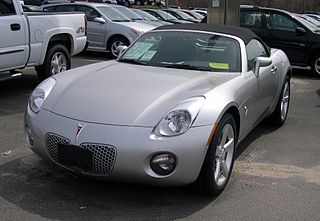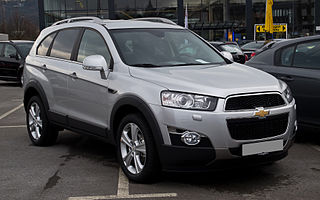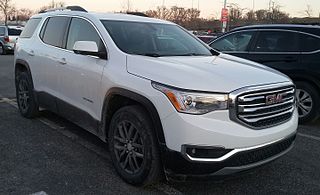
The North American International Auto Show (NAIAS) is an annual auto show held in Detroit, Michigan, U.S., at TCF Center. The show was held in January from 1989 to 2019. It was intended to move to the summer in 2020, but it has been suspended since due to the COVID-19 pandemic in the United States. It is among the largest auto shows in North America. UPI says the show is "regarded as the foremost venue for [car] manufacturers to unveil new products".

Rebranding in the automotive industry is a form of market segmentation used by automobile manufacturers around the world. To allow for product differentiation without designing or engineering a new model or brand, a manufacturer creates a distinct automobile by applying a new badge or trademark to an existing product line.
Captive import is a marketing term and a strategy for a vehicle that is foreign-built and sold under the name of an importer or by a domestic automaker through its own dealer distribution system.

Delta is General Motors' compact front-wheel drive automobile and crossover SUV platform, a successor to the GM T platform; it also replaced GM J platform and the Z platform used by the Saturn S-Series. The platform debuted in the 2003 Saturn Ion. Vehicles of this platform generally carry the letter "A" in the fourth character of their VINs.

Kappa was General Motors' subcompact rear-wheel drive automobile platform for roadster applications. The architecture debuted in the 2006 Pontiac Solstice and 2007 Saturn Sky, and ended production in 2009. These vehicles generally have a "M" in the fourth digit of their VIN.

Epsilon is General Motors' mid-size front-wheel drive automobile platform. The architecture was developed by Opel, and debuted in the 2002 Opel Vectra and 2003 Saab 9-3. Since this platform falls squarely in the center of the worldwide automobile market, GM plans to produce a great many Epsilon vehicles with over a dozen variations. As of 2005, it was GM's highest volume worldwide platform. Even after the dissolution of the GM/Fiat partnership, both companies retain the rights to continue developing Epsilon-derived models.

Theta is General Motors' compact or mid-size crossover SUV automobile platform. The architecture debuted in 2002 with the Saturn Vue and was later used for the Chevrolet Equinox and Captiva and similar models.

Robert Anthony Lutz is a Swiss American automotive executive. He served as a top leader of all of the United States Big Three, having been in succession executive vice president of Ford Motor Company, president and then vice chairman of Chrysler Corporation, and vice chairman of General Motors.

Asüna was a captive import automobile marque created in 1992 for sale in Canada by General Motors as a counterpart to Geo. It was one of two successors to the Passport marque, which had a similar intent.

Wayne K. Cherry is an American car designer educated at Art Center College of Design and employed by General Motors from 1962 through 2004, retiring as Vice President of Design. Cherry worked for General Motors in the United States from 1962 until 1965, when he moved to the United Kingdom to take a position with General Motors' Vauxhall Motors subsidiary, becoming Design Director at Vauxhall in 1975. In 1983 General Motors consolidated all European passenger car design under Cherry and made him Design Director at General Motors' Adam Opel AG subsidiary. Cherry returned to the United States in 1991 and in 1992 became General Motors Vice President of Design. Cherry retired from General Motors in 2004.

The Chevrolet HHR is a retro-styled, high-roofed, five-door, five-passenger, front-wheel drive crossover designed by Bryan Nesbitt and launched by the American automaker Chevrolet at the 2005 Los Angeles Auto Show as a 2006 model.

Specialty Equipment Market Association (SEMA) of the automobile aftermarket was formed in 1963 by Roy Richter, Ed Iskenderian, Els Lohn, Willie Garner, Bob Hedman, Robert E. Wyman, John Bartlett, Phil Weiand Jr, Al Segal, Dean Moon, and Vic Edelbrock Jr. and now consists of 6,383 companies worldwide, bringing together aftermarket manufacturers, original equipment manufacturers (OEM), media, car dealers, specialty equipment distributors, installers, retailers and restoration specialists.

The GMC Acadia is a crossover SUV manufactured by General Motors for GMC marque. The first-generation GMC Acadia shared the GM Lambda platform with the Saturn Outlook, the Chevrolet Traverse, and the Buick Enclave. The Acadia went on sale in 2006 as a 2007 model in the United States, Canada and Mexico. The Acadia replaces three of the 7- or 8-seater vehicles on the Pontiac–Buick–GMC dealership network, the midsize GMC Safari van, the GMC Envoy, and the Pontiac Montana SV6 minivan for the domestic market. As of 2009, the Lambda vehicles have replaced the Buick Rainier, Buick Rendezvous, Buick Terraza, and the GMC Envoy XL and then subsequently the GMC Envoy, Chevrolet TrailBlazer and the Isuzu Ascender. A Denali version of the Acadia debuted for 2011. In 2017, the second generation Acadia was repositioned as a mid-size crossover utility vehicle in order to compete within the growing midsize SUV market against the likes of the Ford Explorer, Edge, and Jeep Grand Cherokee.

The Los Angeles Auto Show is an annual auto show held at the Los Angeles Convention Center in early December. The LA Auto Show is an OICA sanctioned international exhibition and also endorsed by the Greater Los Angeles New Car Dealers Association. It is open to the public for ten days each year, filling 760,000 square feet (71,000 m2) of exhibit space.

In the late 1920s, American automotive company General Motors (GM) launched four companion makes in the North American market to supplement its existing lineup of five car brands, or "makes". The companion makes were LaSalle introduced for the 1927 model year to supplement Cadillac, Marquette introduced in 1929 for 1930 to supplement Buick, Viking introduced for 1929 to supplement Oldsmobile, and Pontiac introduced for 1927 to supplement Oakland. GM's fifth existing make, Chevrolet, did not receive a companion make. With the exception of Viking, which was priced above Oldsmobile, each of the companion makes were slotted immediately below their "parent make" in GM's hierarchy.

Yanase & Co., Ltd. is a retailer of new European and North American vehicles and used cars in Japan. As of the year 2002, Yanase has the rights of exclusive retailer of Mercedes-Benz, Volkswagen, Audi, BMW, Volvo, Saab, Cadillac, Chevrolet, Chrysler, Jeep, Dodge and Smart vehicles to Japanese consumers. It is part of the Itochu group.

The Buick Avenir is a concept car manufactured by Buick. The name of the vehicle "Avenir" means "future" in French. In October 2017, Buick made Avenir a premium top of the line sub-brand, similar to GMC’s Denali and Chevrolet’s Signature series. The Buick LaCrosse and Enclave were the first vehicles to receive this upgrade for the 2018 model year.
The Ramos Arizpe Assembly is a General Motors automobile factory in Ramos Arizpe, Coahuila, Mexico. It opened in 1981 and has manufactured vehicles from Buick, Cadillac, Chevrolet, GMC, Oldsmobile, Pontiac, Saturn, and Saab. It currently produces the Chevrolet Blazer and, along with San Luis Potosi Assembly, the Chevrolet Equinox.


















